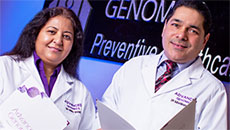Revolutionary new practices with cutting-edge technology has paved the way for radical new medical treatments, touch screen tablets and social media are connecting people across the globe like never before, even the clone of a sheep named Dolly was made possible. Scientists, medical professionals and researchers are constantly pushing the envelope, surpassing their original goals and pushing the frontiers of technology further and further as each passing day comes to an end.
What will be the next big revolutionary discovery made… a more sustainable solution to global warming? A way to solve the rising epidemic of obesity in developed nations in combination to solving world hunger issues in developing countries? The cure for HIV, cancer or other terrible diseases?
We are constantly on the hunt for the latest answers, but the advent of stem cell research may be putting us closer to cures and treatment options for many previously thought incurable diseases and illnesses. Stem cell research involves groundbreaking science and breakthrough medicine in which the benefits are significant and promising.
What are Stem Cells?
What exactly are these microscopic miracles that to this day continue to astound scientists and medical professionals alike? Stem cells are biological cells found in all multi-cellular organisms and are defined by two remarkable abilities. The first attribute is self-renewal which highlights their ability to replicate many times over while remaining in an undifferentiated state. The second is referred to as potency and involves their capacity to differentiate into many different types of specialized cells. The specialization potential of stem cells can range from being unipotent, capable of replenishing only one type of cell, to totipotent, being able to specialize into any type of cell. In fact, totipotent cells are capable of forming an entire, viable organism.
There are two main types of stem cells in mammals, embryonic stem cells and adult stem cells. The former are taken from embryos and are responsible for developing an embryo into specialized cells after conception. The latter are found in adults and replenish tissues and contribute to the body’s repair system. Adult stem cells can be harvested from one’s bone marrow, fat tissue and from blood through various extraction processes. Lastly, stem cells can also be taken from the umbilical cord blood, immediately after birth.
Breakthroughs in Medicine & Treatment

Dr. Anil Mangal is the Medical Director of Lifebank, a member of Insception family, making it one of the largest cord blood banks in Canada.
Because of stem cell’s amazing resourcefulness, they are widely tested and researched throughout all facets of medicine. Their ability to self-renew and give rise to succeeding generations of cells with varying degrees of differentiation capabilities, offers considerable potential for regeneration of diseased and damaged tissues within the body. Stem cell research was heralded as the ‘breakthrough of the year’ in 1999 by Science magazine, and has made progress in leaps and bounds within the last several decades.
By stem cell’s functional definition, they’re able to produce new cells and contribute to one’s immunity over long periods of time. Therefore, a number of different cell therapies have been developed which focus around intervention strategies.
Several different forms of stem cell therapy currently exist; one in particular has spanned nearly three decades and includes using bone marrow stem cells, and more recently, umbilical cord blood stem cells to treat cancer patients suffering from conditions such as leukemia and lymphoma. For example, cytotoxic agents introduced into the body by chemotherapy are unable to discriminate between cancerous cells and hematopoietic stem cells in the bone marrow and often target and kill both.
Stem cell transplant therapy focuses on reversing this unwanted side effect of chemotherapy, by reintegrating stem cells into one’s bone marrow to replace and produce cell’s lost from the body. There are also examples of people who have suffered from terrible spinal cord injuries which caused paralysis, however they were able to regain the ability to walk upon receiving stem cell therapy, adds Lifebank’s Medical Director Dr. Anil Mangal.
Additional areas of research for ongoing potential treatments include brain and spinal cord damage; cancer; Type 1 diabetes mellitus; Parkinson’s, Huntington and celiac disease; cardiac failure, muscle and neurological disorders and countless other illnesses. In the onset of 2012, hundreds of active phase III clinical trials involving stem cell therapy have been registered with varying research organizations.
A remarkable story that made recent headlines in the Globe & Mail, involves Taylor Binns, a 23- year-old Ontario student who regained sight in his left eye after receiving a stem cell transplant surgery. As per the new reports, Taylor received stem cells from his younger sister Tori in a first of its kind treatment performed by Dr. Allan Slomovic at Toronto Western Hospital. This stands as one of many new “treatments that are becoming more readily available with the ongoing success of stem cell therapy research.
Numerous medical professionals and scientists believe stem cell therapies have the potential to change the face of human illnesses.
Stem Cell Therapy Risk & Controversy
Stem cell therapy is still a fairly new concept, thus contributing to scientific and social uncertainty surrounding stem cell research. Because one of the defining characteristics of stem cells is self-renewal, one key concern regarding treatment is the risk of transplanted stem cells forming cancerous tumours if cell division continues uncontrollably. Nonetheless, before all forms of stem cell therapy can be fully applied in clinical settings, more research is necessary to understand stem cell behaviour. This includes further researching the mechanisms of stem cell interaction with the diseased/damaged areas in the body upon transplantation.
One area in particular which has raised concern is the harvesting of embryonic stem cells. The controversy reflects an ethical dilemma regarding the techniques used to extract embryonic stem cells, which requires the destruction of blastocysts. These structures consist of approximately 50-150 cells and are formed early on in the human life development process, shortly after fertilization occurs, according to Sue Smith and Heidi Elmoazzen of Canadian Blood Services (CBS).
This is where the ethical dilemma lies in that these pluripotent cells, capable of producing viable, whole organisms are being destroyed in order to derive the stem cells for research and potential therapy. Contrarily, using adult stem cells in research and therapy have been not nearly as controversial because the destruction of embryos is unnecessary.
Cord Blood Stem Cells

Cord Blood Collection at birth
Recently, procuring stem cells from umbilical cord blood has been widely utilized and remains a much less controversial and less invasive procedure. It involves taking a sample of blood from a newborn baby’s umbilical cord or placenta, materials which are normally designated as waste after pregnancies because they no longer serve an immediate purpose to mother or infant. Cord blood is rich in stem cells but differs from embryonic stem cells in that they are immature and only give rise to cells found in the bloodstream. Regardless, these potent stem cells are used to treat dozens of illnesses including lymphoma, leukemia, anemia and inherited immune system and metabolic disorders, says Smith, who is the CBS’s Executive Director, Stem Cells and Elmoazzen, who is the organization’s Project Director, Public Cord Blood Bank.
Therefore, many expecting parents are moving towards the trend of ‘banking’ their newborn’s cord blood. The hope is that they’ll never have the need to use it; however, should the need arise later in life perchance if the child or a related family member develops an illness that is treatable by cord blood stem cells, they’ll have an abundant resource to utilize. More importantly, the search to find a compatible blood source will also be eliminated saving precious time in treatment for the disease.
“The risks of cord blood collection are really nil because the collection is done after the baby is born. So there’s no risk to the baby or the mother,” explains Dr. Anil Mangal, medical director at Lifebank, a member of the Insception family, making it one of the largest cord blood banks in Canada with the highest level of accreditation (FACT-accredited).
He goes on to say “The primary concern is to take care of the mother and her baby. Very rarely, I’d say less than 1 in a 1,000, we will not collect a sample because of complications that may arise during a pregnancy. Also, it is important to collect within 15 minutes after delivery, otherwise blood starts clotting, so there is a time factor. But in terms of risk to the mother and the baby, there are no risks.”
Furthermore, it’s important to have a racially diverse pool of donors, since research shows that matching cord blood between Caucasian and non-Caucasian donors and recipients is difficult. Therefore, it is encouraged for all women who are considering a pregnancy in the next few years to think about banking their infant’s cord blood, as per British Columbia’s Ministry of Health.
“It is reassuring to know that should our family, Liam or any of his future siblings have the need to use the stem cells that they are there. Of course it is our hope that he will never need to, but knowing that it is there for our child is reassuring,” says Sheila Edmonds, who recently gave birth to Liam. She, along with her husband Kemp, used Lifebank’s services to preserve their first child’s cord blood cells.
“The benefits of saving the cord blood is that it gives us as a family another option for treatment should it ever be needed. And it’s bigger than just Liam, if either of us or members of our family develops a condition that could benefit from stem cells, we have the option there,” she adds.

(RIGHT ) Sue Smith, Canadian Blood Service's Executive Director, Stem Cells. (LEFT) Heidi Elmoazzen is Project Director, Public Cord Blood Bank wih Canadian Blood Services
Smith and Elmoazzen say the storage of the stem cells is a complicated and technical process that ensures the viability of cells over long periods of time. After donations are received, processed and tested, they are then cryopreserved and stored in liquid nitrogen, in which the stem cells remain until they are needed for a patient’s stem cell transplant. In fact, cord blood cells have been successfully transplanted after 13 years of storage without any detected deterioration in quality.
According to the Ministry of Health, “provincial and territorial Ministers of Health, not including Quebec, approved $48 million in funding for a national public umbilical cord blood bank in March 2011.” The ministers chose Canadian Blood Services to manage this project and cord banks will be established in Ottawa in June of 2013 and in Toronto, Edmonton and Vancouver in 2014.
Summary of Benefits & Risks of Cord Blood Stem Cells
As per Canadian Blood Services:
Cord blood is collected in advance, stored and ready for use immediately as needed, decreasing patient wait times for a stem cell donor search
Cord blood transplants can lower the risk of graft-vs-host disease (GvHD), a serious common side effect of unrelated stem cell transplants
Transplanting cord blood stem cells can reduce the risk of transmitting viral infections, which can potentially be lethal for transplant recipients
Cord blood has more lenient human leukocyte antigen (HLA) matching requirements, thus potentially allowing for more likelihood to find a potential match
Cord blood donations involve minimal risk to the donor (infant and mother)
Outcomes from receiving a stem cell transplant will depend on many factors including the level of compatibility between the donor and the recipient, the stage of the disease, the type of disease and the age of the recipient. There are no guarantees for the patient, but a stem cell transplant may be the best hope of returning to good health, conclude Smith and Elmoazzen.
Conclusion
As the world continues to progress at an exponential rate, the terrible things in life as well as the great things both evolve. Stem cell research is one of the great things.
Evolution has paved the way for these microscopic cells to proliferate, specialize and develop into entire multi-cellular organisms. Being able to harness this awesome power to treat damaged tissues and incurable diseases is unimaginable. With new treatment options being made possible through stem cells, this presents an additional solution to increasingly complex problems.
Moreover, the fact that cord blood stem cells are harvested from what would ordinarily be a waste product is quite remarkable in its own right. This provides the possibility that should an infant or a sibling face a terrible illness that stem cell therapy can potentially treat it and provide the reassurance that options are available.
With different organizations making the storage of cord blood cells possible, the questions are beginning to shift from ‘Why’ to ‘Where, When & How’ can I get this done for my family.
There are ethical and moral issues that need to be considered, in addition to more research being needed and conducted to push experimental phase III treatments into clinical settings, but regardless, the future is promising. These truly are exciting times.
BY AMEET SINGH
PHOTO: Memorable moments Photography, Payal Video, Canadian Blood Services, Sheila Edmonds






